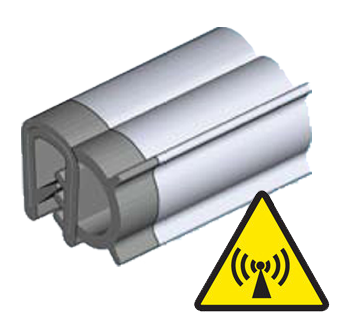5 Design Considerations for EMI Gaskets
 Electromagnetic interference (EMI) has the potential to cripple electronic systems. In military or hospital settings, this could directly lead to loss of life or equipment. In industrial settings, EMI could directly lead to slashed profits by interrupting electronic equipment. To thwart EMI, many designers employ EMI gaskets to shield their products from harmful electromagnetic radiation.
Electromagnetic interference (EMI) has the potential to cripple electronic systems. In military or hospital settings, this could directly lead to loss of life or equipment. In industrial settings, EMI could directly lead to slashed profits by interrupting electronic equipment. To thwart EMI, many designers employ EMI gaskets to shield their products from harmful electromagnetic radiation.
In a previous EMI discussion, we explored common use cases for EMI gaskets in protecting nearby equipment. To properly incorporate EMI gaskets into a design, however, the designer must understand the EMI gasket materials and the final use case for each gasket.
Common EMI Gasket Materials
EMI gaskets are available in a variety of materials, each of which delivers its own benefits and drawbacks. Some of the most common:
- Nickel - Commonly combined with graphite and silicon for reliable and affordable commercial and residential applications.
- Silver - Commonly coated on copper, aluminum, or glass for military and aerospace applications that need to meet MIL-DTL-83528 specifications.
- Rubber - Rubber is often used in special shapes and forms. It is also available in a conductive version.
- Silicone - Silicone is often used in special shapes and forms. It is also available in a conductive version.
- Copper - A cheap, effective conductor used to trap EMI.
- Aluminum - A cheap, effective conductor used to trap EMI.
Design Considerations
Knowing the materials available to your design is half the challenge in battling EMI. The other half is generating answers to these critical design questions:
1. What regulations do you need to comply with?
Different companies are beholden to different regulations, both from the government and industry watchdogs. When custom-designing a product or facility, it’s crucial to understand which regulations you must comply with.
2. What environmental conditions will be present?
The requirements for the EMI gasket will vary depending on the environmental demands. Important factors to consider:
- Does the gasket need to provide waterproofing qualities? If waterproofing is necessary, some materials, like rubber and silicone, will be more important than others.
- Will the gasket be exposed to friction? If so, the gasket will have to be durable enough to endure the wear and tear.
- Will the gasket be exposed to intense heat or cold? If so, your gaskets may expand or shrink, potentially interfering with its EMI shielding capabilities.
The answers to these questions and similar concerns will help determine the type of EMI gasket required.
3. Are there space and weight limitations?
Depending on your space and weight requirements, some gasket materials will be more valuable than others. Take cell phones, for example. Cell phones need to be lightweight and compact, so there are no opportunities for heavy gaskets inside of them. These same considerations must be made in all other EMI applications.
4. What are the device’s operating frequencies? What external frequencies may the device be exposed to?
Higher frequencies can easily slip through small openings in the EMI shielding. The higher the frequencies involved, the tighter the overall design must be. In some cases, this will require different EMI shielding material.
5. Should you account for compression set?
When compression is a factor, your gasket may deform, especially in applications like doors and access panels. As the gasket is compressed over time, it will require higher compression to achieve the same EMI shielding levels as when the gasket material was new. In the absence of higher compression, you may leave space for EMI frequencies to slip through.
By keeping these questions top of mind during the design phase, you’ll ultimately settle on the ideal EMI gasket regardless of the application.
Contact me for more information about EMI gaskets considers for your next design.